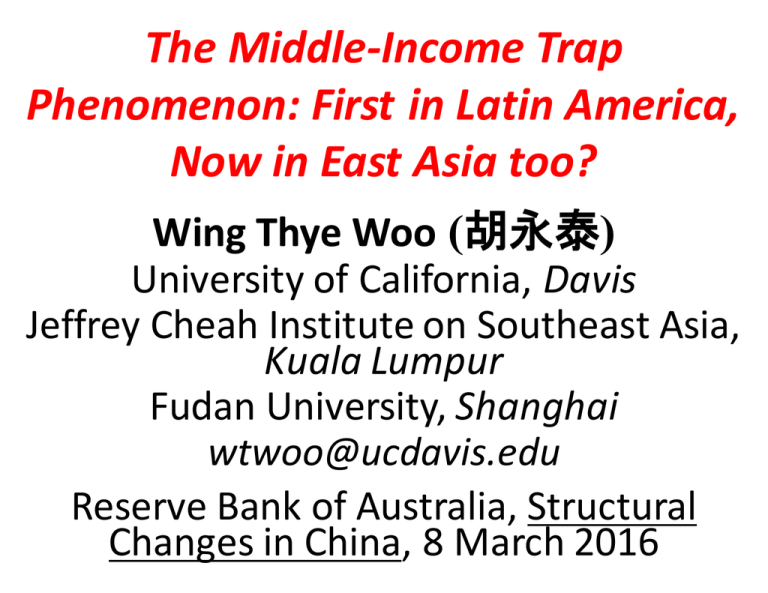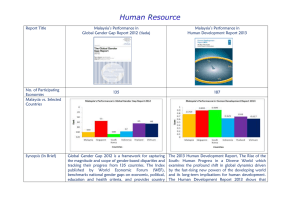Document 10801704
advertisement

The Middle-­‐Income Trap Phenomenon: First in Latin America, Now in East Asia too? Wing Thye Woo (胡永泰) University of California, Davis Jeffrey Cheah Institute on Southeast Asia, Kuala Lumpur Fudan University, Shanghai wtwoo@ucdavis.edu Reserve Bank of Australia, Structural Changes in China, 8 March 2016 TRAP? SHOW ME à The Eyeball Test • Language: “Being in a Trap” has the connotation of being involuntarily confined to a particular location • Question: Does the definition of “middle-­‐income trap” meet the eyeball test of permitting us to visually see a country being confined to a particular location? • Answer: YES, you bet you. Analytical Demarcation • High Income, Middle Income and Low Income – where you draw the separation line depends on the specific question being asked • World Bank (WB) income classification scheme determines degree of concession in WB loans • Our demarcation is to highlight whether a country is converging to the living standard of the global economic leader? Is it catching up? • Catch Up Index (CUI) = level of a country’s living standard relative to US level = development gap • Living Standard = GDP per capita at PPP$ (data for 132 countries from Angus Maddison, 2010) Illustrating the Middle Income Trap: Growth of the Largest Regional Economies For China, not useful to look only at the very richest (e.g. Singapore), so our sample: • 5 largest from Europe: Germany, UK, France, Italy, Sweden • 5 largest from Latin America: Brazil, Mexico, Argentina, Colombia, Chile • 10 largest from East & South Asia: China, India, Japan, Indonesia, S-Korea, Thailand, Taiwan, Pakistan, Philippines, Malaysia 0.0 1962 1963 1964 1965 1966 1967 1968 1969 1970 1971 1972 1973 1974 1975 1976 1977 1978 1979 1980 1981 1982 1983 1984 1985 1986 1987 1988 1989 1990 1991 1992 1993 1994 1995 1996 1997 1998 1999 2000 2001 2002 2003 2004 2005 2006 The Middle-Income Trap: Latin America, Stuck at CUI=30% 60.0 50.0 40.0 30.0 20.0 10.0 Argentina Brazil Chile Colombia Mexico Western Europe: Maintain 70% GDP per capita (PPP) of Western Europe as % of US Level 90.0 85.0 80.0 75.0 70.0 65.0 60.0 55.0 France Germany Italy Sweden UK 06 20 04 20 02 20 00 20 98 19 96 19 94 19 92 19 90 19 88 19 86 19 84 19 82 19 80 19 78 19 76 19 74 19 72 19 70 19 68 19 66 19 64 19 19 62 50.0 Why is European CUI < 100% ? (GNP/L) = (GNP/H)*(H/W)*(W/L) where • GNP = total output • L = Population Size • H = Number of hours actually worked • W = Number of people actually working • (GNP/H) = output per hour worked is very similar in USA & Europe • (H/W)*(W/L) in Europe is 75% of USA 1. Club Convergence is when the largest economies in a region become more alike each other over time. 2. Club Convergence in in South America (Middle-­‐Income Club) and in Western Europe (High-­‐ Income Club). 3. Is East Asia exceptional? Breaking Out of the Pack in Developing Asia: Malaysia and Thailand are the Miracle Economies according to World Bank (1993) GDP per capita (PPP) of Asia-­6 as % of US Level 35.0 30.0 25.0 20.0 15.0 10.0 5.0 China India Indonesia Philippines Thailand Malaysia 06 20 04 20 02 20 00 20 98 19 96 19 94 19 92 19 90 19 88 19 86 19 84 19 82 19 80 19 78 19 76 19 74 19 72 19 70 19 68 19 66 19 64 19 19 62 0.0 Catch-­‐Up in Japan-­‐S.Korea-­‐Taiwan but not in Malaysia-­‐Thailand 90.0 80.0 70.0 60.0 50.0 40.0 30.0 20.0 10.0 0.0 19621964196619681970197219741976197819801982198419861988199019921994199619982000200220042006 Japan S. Korea Taiwan Malaysia Thailand Two Lessons from Malaysia that are Relevant for China Woo, Wing Thye (2011). "Understanding the Middle-­‐ Income Trap in Economic Development: The Case of Malaysia," invited World Economy Lecture delivered at the University of Nottingham, Globalization and Economic Policy (GEP) conference, Globalization Trends and Cycles: The Asian Experiences, Semenyih, Selangor, Malaysia, 13 January 2011; available at http://www.nottingham.ac.uk/gep/documents/lecture s/world-­‐economy-­‐asia-­‐lectures/world-­‐econ-­‐asia-­‐wing-­‐ thye-­‐woo-­‐2011.pdf Lesson 1: Policy Exhaustion. Just doing more of the same will not sustain growth There are stage-­‐specific obstacles to moving up the income ladder. During the earliest catch-­‐up stage as in China in 1978, and in Malaysia in 1970: • general low equality of education and brain drain not barriers to growth because existence of large amount of under-­‐employed agricultural labor allows industrialization via low-­‐tech exports. • if the country becomes a big enough player to affect global parameters, then its national interests requires dealing with economic-­‐political spillovers • destruction of natural environment not a high social concern when country is desperately poor Lesson 2: Catch-up momentum is difficult to maintain unless the various parts of the system are compatible with each other. • Leo Tolstoy in opening of Anna Karenina: “Happy families are all alike; every unhappy family is unhappy in its own way.” • Which is the correct translation, where Y = happiness? (a) Additive? Y = X0 + aX1 + bX2 + cX3 (b) Synergistic? Y = X0 X1a X2b X3c • Eclectic approach: The additive equation (a) works in the short-run but long-run growth is determined by the synergistic equation (b) • Soviet Union reached middle-income without a private market economy but the economy finally imploded Can China Avoid a Malaysia-­‐ Type Malaise? China as a Speeding Car: Types of Potential Crashes (1/2) • Hardware failure (wheel of car comes off): failure in an economic mechanism, e.g. banking sector collapse, fiscal mismanagement. A private market economy is the right hardware to have, and it should be managed according to evidence-based – micro-regulation (e.g. Bela Balassa: non-discriminatory promotion of manufacturing) – macro-adjustment (e.g. Max Corden: exchange rate protection) • Software failure (a fight inside the car): failure in sociopolitical governance, e.g. corruption. Need to have governance institutions that are – administratively responsive and competent – socially inclusive in operation China as a Speeding Car: Types of Potential Crashes (2/2) • Power supply failure (the car ran out of gas or hit a road block): Avoid running out of gas or meeting a road block by being – ecologically sustainable at national & global level – consistent with amicable international relations • A Holistic Approach is required to ensure Compatibility amongst Hardware (base structure, economic structure & policy), Software (superstructure, socio-political institutions) and Power Supply (the BIG picture). Limiting this Talk • Will limit discussion to solving hardware failures and power supply failures • Will skip discussing software failures even though Hu Jintao’s goal of building a Harmonious Society (Hexie Shehui) reveals that Software Failure is deemed to be the most probable type of failure The Worst Hardware Problem Today • Expansion of State Capitalism under Hu-­‐Wen Administration, 2002-­‐2012 = Softening the Budget Constraints of Local Governments and State-­‐Controlled Enterprises, which resulted at – microeconomic level à TFP growth of -­‐2% in 2007-­‐2012 (Harry Wu, 2016) – macroeconomic level à NPLs threaten financial system stability and potential fiscal crisis Emergency Room Medicine in 2009-­‐2010 • 4 trillion yuan fiscal stimulus over 2 years @ 7% of GDP per year • To prevent waste, bring forward investment projects that would be inevitably implemented, (Obama called this “shovel-­‐ready projects”) e.g. – Hard Infrastructure: roads, bridges, ports, high-­‐ speed train, telecommunications –Industries of tomorrow: develop alternative energy e.g. solar power – Urbanization: housing to accelerate rural-­‐to-­‐urban migration (lesson of Pudong: build and they will come) • Masterful Keynesian countercyclical policy? Woo’s Prediction, 17 Feb 2009, at US Congress • “China’s growth in 2009 is likely to lie closer to Premier Wen’s 8 % target than to the IMF’s projection of 6.7 % … The state-­‐owned banks (SOBs) will be happy to obey the command to increase lending because they cannot now be held responsible for future nonperforming loans. The local governments and the state-­‐owned enterprises (SOEs) can now satisfy more of their voracious hunger for investment motivated by the soft-­‐budget constraint situation where the profits would be privatized and the losses socialized. The stimulus package will [therefore] work well …. The price … will be paid later by the recapitalization of the SOBs and a more depleted natural environment.” • GDP growth was 9.2% in 2009 and 10.6% in 2010 Excess Capacity Galore à NPLs The 2015 Stock Market Debacle • Question: How to prevent NPLs from appearing? • Answer: Firms issue new stocks and use proceeds to repay bank loans. • Action: Government talks up the stock market. • Outcome: Crash was inevitable: “What rate of return could a zombie firm pay on its equities when it cannot even afford the average bank interest rate?” A rate lower than the average interest rate! • Using stock market to solve NPLs à 2015 bubble Faster Convergence to a Modern Private Market Economy is Solution to Hardware Problem • Financial market reform to use market allocation because infrastructure is now not #1 binding growth constraint – Promote private small-­‐medium banks à loans to SMES & rural firms • Land policy reform – privatize rural land (collateral for rural entrepreneurs) – public housing under principle of future home ownership as in Singapore • “Hukou” & labor-­‐social protection reform – promote urbanization process without discrimination against coastal cities • Greatly reduce the economic role of the state planning agency, local governments and SOEs to eliminate soft-­‐budget constraint Power Supply Failures: China’s Neglected Vulnerabilities Some Potential Power Supply Failures Physical environment • air: pollution and health; greenhouse gases and climate change • water: declining rainfall in northern China, and three canals for south-­‐to-­‐north transfer of water. International concern over access to water from Tibetan plateau International environment. Avoid external sanctions from Mis-­‐Steps in: • complacency about trade protectionism • inept foreign relations Inept Foreign Relation #1: Failure of WTO Doha Rounds negotiations in Potsdam, June 2007 (1/3) • Key obstacle WTO Doha Rounds started in 2001 is (a) refusal of developed countries to reduce agricultural subsidies, and (b) refusal of developing countries to reduce industrial tariffs. June 2007: Leaders of both sides (G4) – developed countries represented by USA and EU, and developing countries by Brazil and India – met in Potsdam, Germany. • USA-EU offered to lower agricultural protection but Brazil-India refused to lower industrial protection • “India and Brazil’s fear of growing Chinese imports was behind their decision to help prompt the collapse on Thursday of the G4 trade talks in Potsdam, said Susan Schwab, the US trade Representative” (Schwab surprised by stance of India and Brazil, Financial Times, 22 June 2007) • “Beijing has taken a back seat in much of the Doha negotiations so far, despite urgings from the US to take a leading role.” (Negotiators sift debris, Financial Times, 29 July 2008). • Why did China not take leadership position of developing countries and defended its interests against Brazil-India? Inept Foreign Relation #2: Copenhagen Summit, Dec 2009 (2/3) • “We did not get an agreement on 50% reductions in global emissions by 2050 or on 80% reductions by developed countries. Both were vetoed by China, despite the support of a coalition of developed and the vast majority of developing countries” Ed Milliband, UK secretary for energy and climate change, in his column, ‘The Road from Copenhagen’, The Guardian, 20 Dec 2009 • Premier Wen Jiabao was the only head of state present in Copenhagen who did not show up for the last summit session and participated in the discussions via messages relayed by Chinese officials at the conference site. China should scale up its efforts to prevent power supply failures • ensure national and local environmental sustainability: abandon the “man over nature” mentality (as exemplified by the story of “the stupid old man and the mountain”) • adopt responsible stakeholder stance in diplomatic relations: – abandon the “free rider practice” -­‐-­‐ as exemplified in the 2007 WTO Doha rounds negotiation and the 2009 Copenhagen Climate Change Summit – avoid Second Cold War e.g. South China Sea, nuclear proliferation







